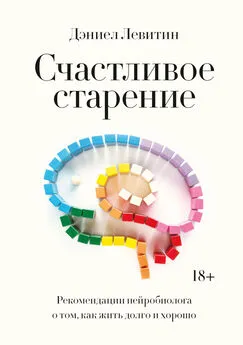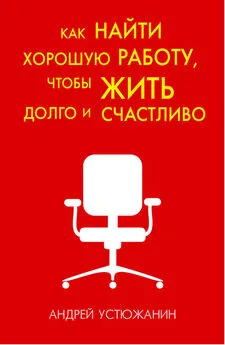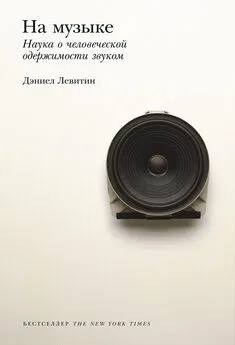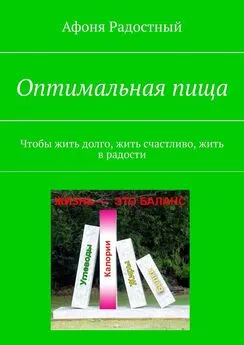Дэниел Левитин - Счастливое старение. Рекомендации нейробиолога о том, как жить долго и хорошо
- Название:Счастливое старение. Рекомендации нейробиолога о том, как жить долго и хорошо
- Автор:
- Жанр:
- Издательство:Манн, Иванов и Фербер
- Год:2021
- Город:Москва
- ISBN:9785001695868
- Рейтинг:
- Избранное:Добавить в избранное
-
Отзывы:
-
Ваша оценка:
Дэниел Левитин - Счастливое старение. Рекомендации нейробиолога о том, как жить долго и хорошо краткое содержание
Ответы на эти и многие другие вопросы вы найдете в книге известного нейробиолога и автора бестселлеров о природе возрастных изменений и о том, как можно прожить долго и что нужно делать сейчас (в любом возрасте), чтобы в 70, 80 и 90 жить полной жизнью.
Книга предназначена для широкого круга читателей.
На русском языке публикуется впервые.
Счастливое старение. Рекомендации нейробиолога о том, как жить долго и хорошо - читать онлайн бесплатно ознакомительный отрывок
Интервал:
Закладка:
R. Y. Hwang et al., “Nociceptive Neurons Protect Drosophila Larvae from Parasitoid Wasps,” Current Biology 17, no. 24 (2007): 2105–2116; Nagasako et al., “Congenital Insensitivity to Pain.”
453
R. J. Crook et al., “Nociceptive Sensitization Reduces Predation Risk,” Current Biology 24, no. 10 (2014): 1121–1125.
454
D. Netburn, “What Injured Squid Can Teach Us about Irritability and Pain,” Los Angeles Times, May 8, 2014.
455
L. Tiemann et al., “Behavioral and Neuronal Investigations of Hypervigilance in Patients with Fibromyalgia Syndrome,” PLoS One 7, no. 4 (2012): e35068.
456
S. Linton, Understanding Pain for Better Clinical Practice: A Psychological Perspective, vol. 16 (New York: Elsevier Health Sciences, 2005), p. 15.
457
R. Moore and I. Brodsgaard, “Cross-Cultural Investigations of Pain,” Epidemiology of Pain (1999): 53–80.
458
Linton, Understanding Pain, p. 14.
459
Linton, Understanding Pain, p. 3.
460
D. D. Price, D. G. Finniss, and F. Benedetti, “A Comprehensive Review of the Placebo Effect: Recent Advances and Current Thought,” Annual Review of Psychology 59 (2008): 565–590.
461
R. Dobrila-Dintinjana and A. Načinović-Duletić, “Placebo in the Treatment of Pain,” Collegium Antropologicum 35, no. 2 (2011): 319–323.
462
P. Tétreault et al., “Brain Connectivity Predicts Placebo Response across Chronic Pain Clinical Trials,” PLoS Biology 14, no. 10 (2016): e1002570.
463
M. Cummings, “Modellvorhaben Akupunktur – a Summary of the ART, ARC and GERAC Trials,” Acupuncture in Medicine 27, no. 1 (2009): 26–30; K. Linde et al., “The Impact of Patient Expectations on Outcomes in Four Randomized Controlled Trials of Acupuncture in Patients with Chronic Pain,” Pain 128, no. 3 (2007): 264–271; D. C. Cherkin et al., “A Randomized Trial Comparing Acupuncture, Simulated Acupuncture, and Usual Care for Chronic Low Back Pain,” Archives of Internal Medicine 169, no. 9 (2009): 858–866.
464
J. S. Mogil et al., “Melanocortin-1 Receptor Gene Variants Affect Pain and μ-opioid Analgesia in Mice and Humans,” Journal of Medical Genetics 42, no. 7 (2005): 583–587.
465
D. Francis et al., “Nongenomic Transmission across Generations of Maternal Behavior and Stress Responses in the Rat,” Science 286, no. 5442 (1999): 1155–1158.
466
D. Kahneman et al., “When More Pain Is Preferred to Less: Adding a Better End,” Psychological Science 4, no. 6 (1993): 401–405.
467
Linton, Understanding Pain, p. 14.
468
US Department of Health and Human Services, “What Is the U.S. Opioid Epidemic?” January 22, 2019, https://www.hhs.gov/opioids/about-the-epidemic/index.html; National Institute on Drug Abuse, “Opioid Overdose Crisis,” January 2019, https://www.drugabuse.gov/drugs-abuse/opioids/opioid-overdose-crisis.
469
T. J. Atkinson et al., “Medication Pain Management in the Elderly: Unique and Underutilized Analgesic Treatment Options,” Clinical Therapeutics 35, no. 11 (2013): 1669–1689.
470
B. R. Da Costa et al., “Effectiveness of Non-Steroidal Anti-Inflammatory Drugs for the Treatment of Pain in Knee and Hip Osteoarthritis: A Network Meta-Analysis,” Lancet 390, no. 10090 (2017): e21–e33.
471
C. A. Heyneman, C. Lawless-Liday, and G. C. Wall, “Oral versus Topical NSAIDs in Rheumatic Diseases,” Drugs 60, no. 3 (2000): 555–574.
472
C. Villemure et al., “Insular Cortex Mediates Increased Pain Tolerance in Yoga Practitioners,” Cerebral Cortex 24, no. 10 (2013): 2732–2740. Было изучено несколько стилей йоги: практика физических поз (асана на санскрите), дыхательные упражнения (пранаяма), упражнения на концентрацию, которые направляют и стабилизируют внимание (дхарана), и медитация (дхьяна).
473
M. H. Pitcher et al., “Modest Amounts of Voluntary Exercise Reduce Pain-and Stress-Related Outcomes in a Rat Model of Persistent Hind Limb Inflammation,” Journal of Pain 18, no. 6 (2017): 687–701.
474
Из личного общения с Джеффри Могилом 20 июля 2019 года.
475
R. W. Shields, “Peripheral Neuropathy,” August 2010, www.clevelandclinicmeded.com/medicalpubs/diseasemanagement/neurology/peripheral-neuropathy/.
476
R. Hill, “NK1 (Substance P) Receptor Antagonists– Why Are They Not Analgesic in Humans?” Trends in Pharmacological Sciences 21, no. 7 (2000): 244–246.
477
K. Ebner and N. Singewald, “The Role of Substance P in Stress and Anxiety Responses,” Amino Acids 31, no. 3 (2006): 251–272.
478
S. W. Park et al., “Substance P Is a Promoter of Adult Neural Progenitor Cell Proliferation under Normal and Ischemic Conditions,” Journal of Neurosurgery 107, no. 3 (2007): 593–599.
479
T. W. Reid et al., “Stimulation of Epithelial Cell Growth by the Neuropeptide Substance P,” Journal of Cellular Biochemistry 52, no. 4 (1993): 476–485; S. M. Brown et al., “Neurotrophic and Anhidrotic Keratopathy Treated with Substance P and Insulinlike Growth Factor 1,” Archives of Ophthalmology 115, no. 7 (1997): 926–927.
480
V. Gangadharan and R. Kuner, “Pain Hypersensitivity Mechanisms at a Glance,” Disease Models and Mechanisms 6, no. 4 (2013): 889–895.
481
A. Latremoliere and C. J. Woolf, “Central Sensitization: A Generator of Pain Hypersensitivity by Central Neural Plasticity,” Journal of Pain 10, no. 9 (2009): 895–926.
482
A. B. Fleischer, T. J. Meade, and A. B. Fleischer, “Notalgia Paresthetica: Successful Treatment with Exercises,” Acta Dermato-venereologica 91, no. 3 (2011): 356–357.
483
M. C. Bushnell, M. Čeko, and L. A. Low, “Cognitive and Emotional Control of Pain and Its Disruption in Chronic Pain,” Nature Reviews Neuroscience 14, no. 7 (2013): 502.
484
N. J. Stagg et al., “Regular Exercise Reverses Sensory Hypersensitivity in a Rat Neuropathic Pain Model: Role of Endogenous Opioids,” Anesthesiology 114, no. 4 (2011): 940–948.
485
Linton, Understanding Pain, p. 28.
486
K. B. Jensen et al., “Evidence of Dysfunctional Pain Inhibition in Fibromyalgia Reflected in rACC during Provoked Pain,” Pain 144, nos. 1–2 (2009): 95–100; M. N. Baliki et al., “Chronic Pain and the Emotional Brain: Specific Brain Activity Associated with Spontaneous Fluctuations of Intensity of Chronic Back Pain,” Journal of Neuroscience 26, no. 47 (2006): 12165–12173.
487
K. D. Davis and M. Moayedi, “Central Mechanisms of Pain Revealed through Functional and Structural MRI,” Journal of Neuroimmune Pharmacology 8, no. 3 (2013): 518–534.
488
Из личного общения с Джеффри Могилом 5 июня 2018 года.
489
M. C. S. Rodrigues and C. D. Oliveira, “Drug-Drug Interactions and Adverse Drug Reactions in Polypharmacy among Older Adults: An Integrative Review,” Revista Latino-Americana de Enfermagem (2016): 24.
490
O. C. Gleason, “Delirium,” American Family Physician 67, no. 5 (2003): 1027–1034.
491
A. A. Kondratova and R. V. Kondratov, “The Circadian Clock and Pathology of the Ageing Brain,” Nature Reviews Neuroscience 13, no. 5 (2012): 325.
492
Такое начало основано на вступительной части следующей статьи: U. Schibler and P. Sassone-Corsi, “A Web of Circadian Pacemakers,” Cell 111, no. 7 (2002): 919–922.
493
T. Roenneberg and M. Merrow, “The Circadian Clock and Human Health,” Current Biology 26, no. 10 (2016): R432–R443.
494
J. C. Dunlap and J. J. Loros, “Making Time: Conservation of Biological Clocks from Fungi to Animals,” Microbiology Spectrum 5, no. 3 (2017).
495
R. Lehmann et al., “Morning and Evening Peaking Rhythmic Genes Are Regulated by Distinct Transcription Factors in Neurospora crassa,” in Information and Communication Theory in Molecular Biology, ed. M. Bossert, Lecture Notes in Bioengineering (Cham, Switzerland: Springer, 2018).
496
L. L. Moroz et al., “Neuronal Transcriptome of Aplysia: Neuronal Compartments and Circuitry,” Cell 127, no. 7 (2006): 1453–1467.
497
Genetic Science Learning Center, “The Time of Our Lives,” March 1, 2016, https://learn.genetics.utah.edu/content/basics/clockgenes/.
498
O. Froy, “Circadian Rhythms, Aging, and Life Span in Mammals,” Physiology 26, no. 4 (2011): 225–235; H. Li and E. Satinoff, “Fetal Tissue Containing the Suprachiasmatic Nucleus Restores Multiple Circadian Rhythms in Old Rats,” American Journal of Physiology – Regulatory, Integrative and Comparative Physiology 275, no. 6 (1998): R1735–R1744.
499
Предположительно часы есть в каждой клетке человека. Например, они обнаружены в надпочечниках, пищеводе, легких, печени, поджелудочной железе, селезенке, вилочковой железе, коже и головном мозге.
500
S. B. S. Khalsa et al., “A Phase Response Curve to Single Bright Light Pulses in Human Subjects,” Journal of Physiology 549, no. 3 (2003): 945–952; K. N. Paul, T. B. Saafir, and G. Tosini, “The Role of Retinal Photoreceptors in the Regulation of Circadian Rhythms,” Reviews in Endocrine and Metabolic Disorders 10, no. 4 (2009): 271–278; J. M. Zeitzer et al., “Response of the Human Circadian System to Millisecond Flashes of Light,” PLoS One 6, no. 7 (2011): e22078; P. C. Zee and P. Manthena, “The Brain’s Master Circadian Clock: Implications and Opportunities for Therapy of Sleep Disorders,” Sleep Medicine Reviews 11, no. 1 (2007): 59–70.
501
C. Dibner and U. Schibler, “Circadian Timing of Metabolism in Animal Models and Humans,” Journal of Internal Medicine 277, no. 5 (2015): 513–527.
502
S. Hood and S. Amir, “The Aging Clock: Circadian Rhythms and Later Life,” Journal of Clinical Investigation 127, no. 2 (2017): 437–446.
503
G. Asher and P. Sassone-Corsi, “Time for Food: The Intimate Interplay between Nutrition, Metabolism, and the Circadian Clock,” Cell 161 (2015): 84–93.
Читать дальшеИнтервал:
Закладка:








![Дэниел Левитин - Путеводитель по лжи [Критическое мышление в эпоху постправды]](/books/1101191/deniel-levitin-putevoditel-po-lzhi-kriticheskoe-my.webp)

